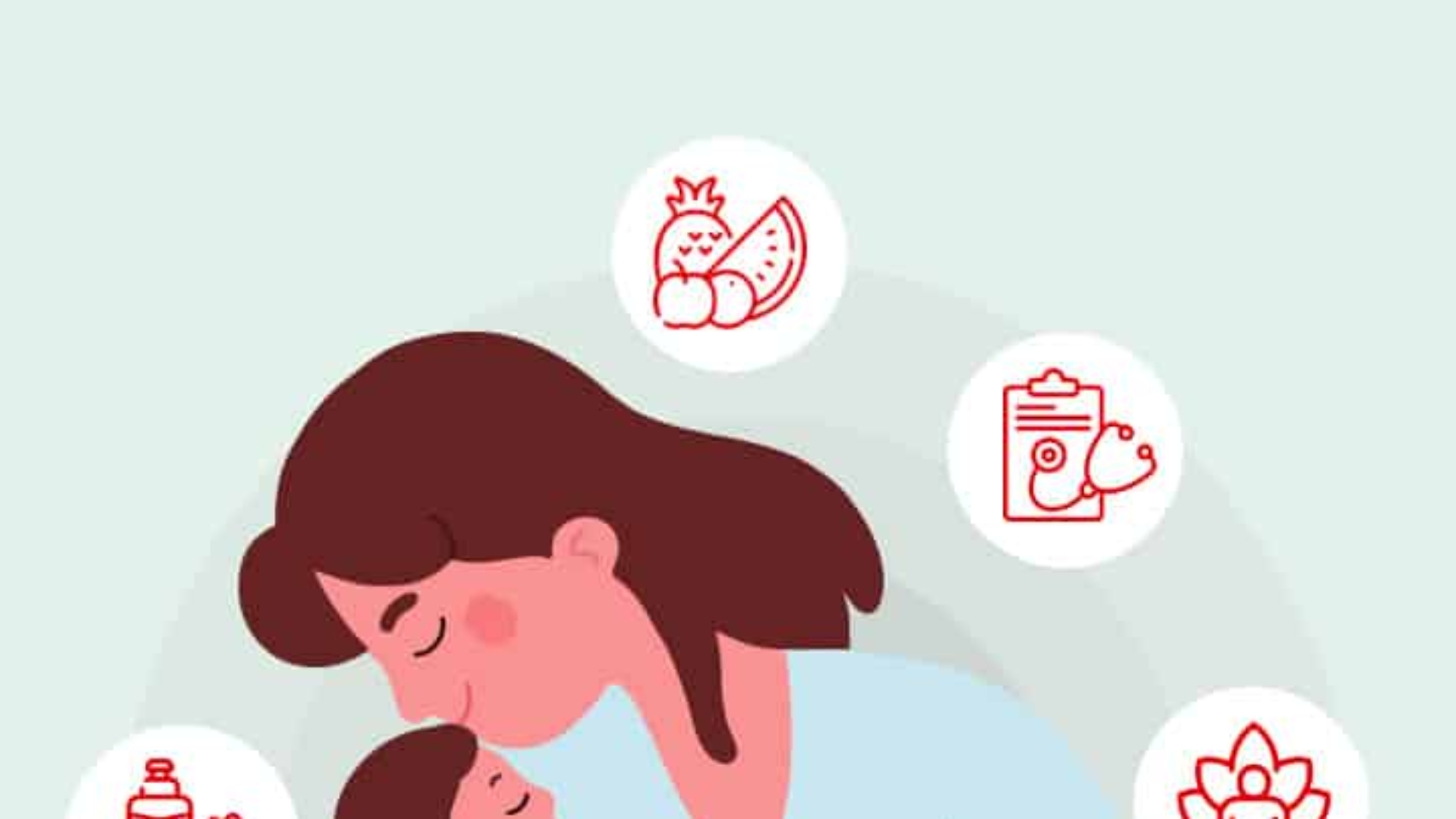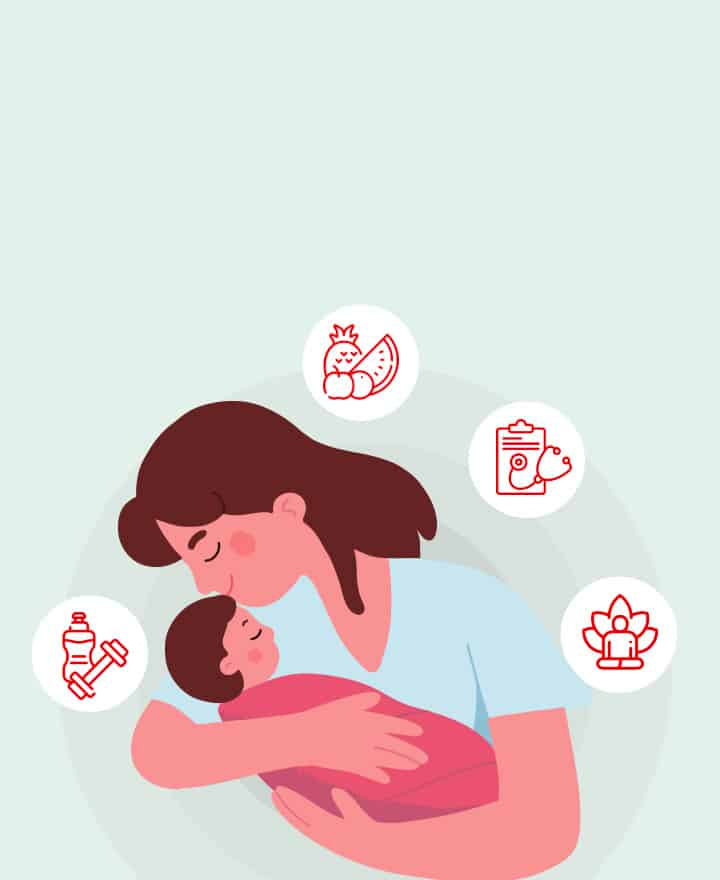Being a mother is an amazing experience, but it presents a unique set of difficulties, particularly in the postpartum period. For new mothers to recuperate from childbirth and get used to their new roles, postpartum care is essential. To facilitate a more seamless transition, this handbook addresses typical difficulties encountered at this time and provides helpful guidance.

Introduction to Postpartum Care
While welcoming a new baby is an exciting moment, new mothers must also prepare for a lengthy adjustment period. The “fourth trimester,” or postpartum period, is a time of healing and adjustment. This post will explore the different facets of postpartum care, providing insightful analysis and useful advice to assist new moms in navigating this demanding yet gratifying period.
It’s critical to recognize and deal with the typical difficulties that emerge during the postpartum phase. These difficulties can include anything from hormonal imbalances and physical discomfort to poor sleep and emotional health. Every new mother’s experience is different, but if you know how to deal with these obstacles, the process will go more smoothly. With the help of this thorough handbook, new moms will be equipped with the knowledge and resources they need to thrive during this crucial time. It offers insightful analysis and helpful advice on postpartum care.
The many facets of postpartum care will be discussed in this article, including bonding with your baby, getting professional assistance, managing postpartum pain, exercising after giving birth, nutrition and hydration, sleep and rest, breastfeeding difficulties, and physical and emotional recovery. By concentrating on these areas, we wish to support a healthy and happy transition into motherhood by providing new moms with the information and resources they require to effectively manage the postpartum phase.
Understanding Postpartum Care
The physical, emotional, and mental well-being of a mother after giving birth is included in postpartum care. Prioritizing self-care is crucial to a speedy recovery and preservation of general well-being. Usually lasting six weeks, this period may extend further based on specific conditions. The emphasis is on the mother’s adjustment to the responsibilities of caring for a newborn as well as her recuperation following childbirth.
Physical Recovery
Recovery Following Childbirth
Pregnancy and childbirth cause major changes to the body. You should expect to feel tired and uncomfortable while your body repairs. These pointers can help with your physical recovery:
Take a nap and recover.
It takes time for your body to heal. Get plenty of rest and steer clear of physically demanding activities. Rest is essential, even though it may seem easier said than done especially when you have an infant to tend to. Aim to take naps when your baby does, and don’t be afraid to ask for assistance with domestic duties or looking after older kids.
Keep an Eye on the Bleeding
Lochia, or postpartum hemorrhage, is a common occurrence. It should diminish over a few weeks. It may start heavy and red, like during a menstrual cycle, but it will gradually lighten in color and become less frequent. Get in touch with your healthcare practitioner if you have significant clots or severe bleeding.
How to Take Care of Your Stitches
To avoid infection, keep the incision clean and dry if you had an episiotomy or cesarean section. Observe your doctor’s care recommendations, which may involve avoiding physically demanding activities that could strain the incision and carefully cleaning the area with soap and water.
Handling Changes in Hormones
Among other symptoms, mood swings and irritation might be brought on by hormonal changes. This is a typical phase of the healing process after giving birth. It’s critical to:
Maintain Hydration
To help keep your hormones in balance, drink a lot of water. Feelings of exhaustion and agitation can be made worse by dehydration, so carry a water bottle with you and sip throughout the day.
Consume Foods High in Nutrients
Eating a well-balanced diet can assist in controlling your energy and mood. Make sure to consume an abundance of fruits, veggies, whole grains, and lean meats. Foods high in nutrients give your body the vitamins and minerals it needs to heal and, if you’re nursing, to support lactation.
Mental Health
Knowing If You Have Postpartum Depression
While many new moms have “baby blues,” prolonged melancholy or anxiety could be a sign of postpartum depression. Among the symptoms are:
Sustaining Sadness
being depressed or empty. It could be challenging to find happiness in past hobbies, like spending time with your child, as a result.
Absence of Interest
losing interest in things you used to enjoy doing. Hobbies, interacting with friends and family, and even routine tasks may fall under this category.
Tolerance
Being angry or frustrated all the time. This can be aimed at your baby, your partner, or even the older kids.
Looking for Psychological Assistance
Don’t be afraid to ask for assistance if you need it. Join a support group, confide in close family members, or speak with a healthcare professional. It can be relieving and lessen your sense of loneliness to express your sentiments to other people. There are postpartum care groups in many towns where you can meet other new mothers going through similar struggles.
Consumption and Drinking Water
A Well-Balanced Diet to Aid in Healing
A well-balanced diet is essential for both nursing and recuperation. Add:
Trim Proteins
necessary for the repair of tissue. Beans, nuts, seafood, and poultry are good sources.
Produce and Fruits
Give the vitamins and minerals that are required. To make sure you’re getting a wide spectrum of nutrients, aim for a variety of hues.
Complete Grains
aid in maintaining energy levels. Opt for oats, brown rice, and whole wheat bread instead of processed grains.
The Value of Hydration
It is essential to stay hydrated for both nursing and general wellness. Make it a daily goal to consume 8–10 glasses of water. You might require extra if you’re nursing to support milk production. Drink a glass of water at each feeding session and think about carrying a water bottle with you all day.
Rest and Sleep
Dealing with Lack of Sleep
A common problem for new moms is sleep deprivation. Here are a few coping mechanisms:
When The Baby Naps, Take a Nap
You can catch up on sleep by taking a nap during your baby’s slumber. Even quick naps have the power to revive. While it may be tempting to utilize your baby’s naps to finish up household duties, getting enough sleep is crucial to your recuperation.
Distribute Accountabilities
Assign your partner or family members to take care of you at night. Your spouse can assist with changing diapers and putting the infant to sleep if you’re nursing. When feeding someone from a bottle, alternate who feeds them.
Establishing a Calm Environment
Make sure the space where you sleep is cozy and restful. Keep the room chilly and utilize blackout curtains. To block out background noise, think about utilizing fans or white noise devices.
Breastfeeding Difficulties
Typical Problems and Their Fixes
Breastfeeding is not always easy. Typical problems consist of:
Issues with Latching
Consult a lactation specialist for advice. A good latch is essential for both preventing nipple discomfort and promoting successful breastfeeding. A lactation consultant can provide tailored guidance and assistance.
Sore Nipples
For solace and healing, apply lanolin cream. After feedings, let your nipples air dry, and think about using breast shells to keep uncomfortable nipples from rubbing against clothes.
Sustaining the Milk Supply
To keep the milk supply healthy:
Eat Often
Regularly breastfeed your infant. Your body will create more milk the more you nurse. Try to get in between 8 and 12 feedings a day.
Continue to Eat and Stay Hydrated.
Milk production is supported by proper nutrition and hydration. Eat a balanced diet with a focus on nutrient-dense foods and drink lots of water.
Handling Pain After Delivery
Postpartum Pain Types
There are several ways that postpartum pain might appear, including:
Pain in the Perineum
For relief, use sitz baths and ice packs. Ibuprofen and other over-the-counter painkillers are examples of useful products.
Engorgement of the Breasts
Before feeding, apply warm compresses, and after, cold compresses. After a few days, when your body becomes used to your baby’s feeding pattern, engorgement normally goes away.
Techniques for Pain Relief
Over-the-Counter Drugs:
Ask your doctor about safe methods of treating pain. For postpartum use, acetaminophen and ibuprofen are usually regarded as safe, although it’s important to see your doctor.
Alternative Medical Interventions
Massage or acupuncture are options for treating pain. These treatments can ease pain and encourage calmness.
Exercise Following Parturition
Advantages of Exercise After Delivery
Mild exercise can boost mood and speed up healing. Advantages consist of:
Enhanced Vitality
Frequent exercise increases one’s energy levels. Your mood can change significantly even after only a few short walks.
Enhanced Sentiment
Endorphins are released during exercise and improve mood. Particularly helpful exercises include mild stretching and postpartum yoga.
Safe Workout Techniques
Begin with low-impact exercises such as postpartum yoga or walking. Before starting any workout regimen, check with your healthcare physician to make sure it’s appropriate for your particular circumstances. Pay attention to your body and refrain from overexerting yourself.
Developing a Bond with Your Infant
The Value of Attachment
Developing a strong bond with your infant is essential for their emotional growth. Among the ways to bond are:
Touch of Skin to Skin
To help your infant feel secure, hold them close. The body temperature and heart rate of your infant can also be regulated by skin-to-skin contact.
Maintain Eye Contact
When you feed or cuddle with your baby, look into their eyes. This can deepen your bond and provide your child with a sense of security and affection.
Engaging Games
Take part in bonding activities together, such as talking, singing, and gentle play. In addition to being beneficial for your baby’s growth, tummy time fosters communication.
Getting Expert Assistance
When to Speak with a Medical Professional
It’s critical to consult a physician if you encounter:
Excruciating Pain
continuous or getting worse pain. This can indicate an infection or another issue that requires medical care.
Indices of Contamination
Fever, edema, or redness. Get in touch with your healthcare practitioner right once if you have any of these symptoms.
Support for Mental Health
For assistance, if you’re experiencing emotional difficulties, speak with a mental health expert. Anxiety and postpartum depression are curable conditions, and receiving treatment as soon as possible will greatly aid in your recovery.
Establishing a Network of Support
Including Friends and Family
Having a network of support is essential. Strategies to increase support include:
Assigning Assignments
Seek assistance from friends and family for domestic tasks. Accept offers of help without hesitation, whether it is for cleaning, running errands, or preparing meals.
Taking Part in Support Groups
Make connections with other new moms for support and company. Postpartum care groups are available in many places, where you can get support and share your experiences.
Expert Assistance
If necessary, think about obtaining professional childcare services or employing a postpartum doula. A postpartum doula can offer both emotional and physical support.
Conclusion
The postpartum phase is a period of profound transformation and adaptation. Making postpartum care a priority is crucial for a speedy recovery and general well-being. By attending to their physical, emotional, and nutritional requirements, new moms can go through this stage with greater ease and assurance. Recall that establishing a support network and asking for assistance are essential measures to guaranteeing a happy and healthy postpartum experience.
Postpartum care is more than simply physical healing; it also involves promoting the mother’s emotional and mental well-being. Maternities can prevent protracted challenges and concentrate on their own and their child’s well-being by identifying the symptoms of postpartum depression and getting treatment as soon as possible. A balanced diet, modest exercise, and bonding activities can all help to improve the postpartum experience and encourage a better way of living.
To sum up, postpartum care is a complex process that involves attending to a new mother’s needs in many spheres of her life. New moms can have a better and happier start to parenting by making self-care a priority and getting the assistance they need to get through the postpartum period. Both the mother and her child may have more balanced and meaningful lives if they approach this time with initiative and knowledge.


